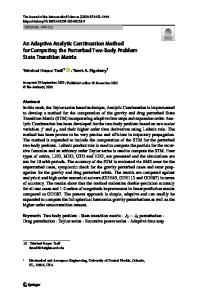Matrix Method for Determining the Body Attitude
- PDF / 146,328 Bytes
- 5 Pages / 595 x 794.048 pts Page_size
- 59 Downloads / 396 Views
International Applied Mechanics, Vol. 56, No. 3, May, 2020
MATRIX METHOD FOR DETERMINING THE BODY ATTITUDE
L. M. Ryzhkov
The problem of determining the body attitude in matrix form using the least-squares method is considered. A loss function that allows us to theoretically analyze the influence of the measurement errors on the accuracy of the attitude for an arbitrary number of vectors without the need for the mutual perpendicularity of the vectors. The proposed method allows us to use measurable quantities with weight coefficients. Keywords: attitude determination, matrix, least-squares method, errors Introduction. The problem of determining the attitude of a body is considered as the problem of determining the matrix of the direction cosines for the transformation between the reference coordinate system and the coordinate system fixed to the body, using information about the vector projections in these coordinate systems [1, 2, 6]. The theoretical analysis of the influence of measurement errors on the accuracy of calculations in [4, 5] was based on the assumption of perpendicular vectors, which narrows the scope of this method. Let us solve the problem without this assumption. The task is to properly select the loss function since the requirement for the mutual position of vectors depends on its type. 1. Problem Solving. Attitude determination using the least-squares method (Wahba’s problem [7]) consists in determining an orthogonal matrix with determinant + 1, minimizing the loss function l
n
l
g (R ) =
n
1 1 m j | | a ji - Ra oji | |2 = å å | | a ji - Ra oji | |2 , å å 2 i =1 j =1 2 i =1 j =1
(1)
where a ji , a oji are vectors in coordinate system fixed to the body and in the reference coordinate systems; a ji = m j a ji , a oji = m j a oji , m j are weight coefficients; n is the number of vectors; l is the number of measurement cycles. Expression (1) can be written as follows: l
g (R ) =
[
]
1 å tr ( M i - RM o )( M i - RM o )T , 2 i =1
(2)
where M i = [ a1i a 2 i K a ni ], M o = [ a o1 a o 2 K a on ] . To simplify further transformations and remove the requirement on the mutual perpendicularity of vectors, the loss function is written as follows: l
g (R ) =
[
1 å tr ( M i - RM o )E[(M i - RM o )E ]T 2 i =1
]
l
=
1 å tr[(M i E - RM o E )(M i E - RM o E )T ] , 2 i =1
(3)
National Technical University of Ukraine “Igor Sikorsky Kyiv Polytechnic Institute,” 37 Pobedy Av., Kyiv, Ukraine 03056; e-mail: [email protected]. Translated from Prikladnaya Mekhanika, Vol. 56, No. 3, pp. 122–126, May–June 2020. Original article submitted December 17, 2018. 1063-7095/20/5603-0367 ©2020 Springer Science+Business Media, LLC
367
where the matrix E will be found from the condition M o E = I.
(4)
For the square matrix M o , we have E = M o-1 . For the rectangular matrix M o , we define the matrix E in the form E = M To ( M o M To ) -1 . The matrix M o M To has size 3´ 3 and rank 3, i.e., has an inverse matrix. Then l
g (R ) =
l
1 1 tr[( M i E - R )( M i E - R )T ] = å tr ( M i EE T M Ti - M i
Data Loading...











